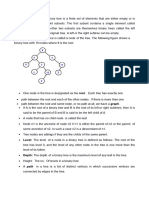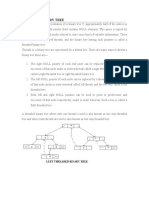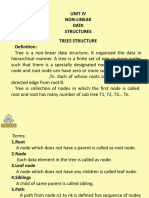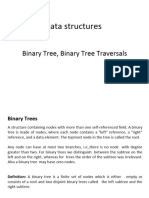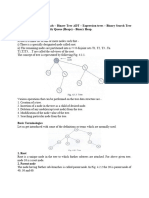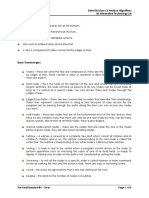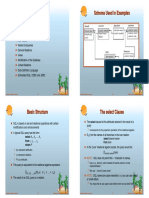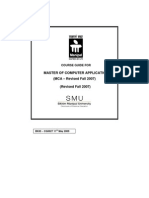Definition of Trees
Definition of Trees
Uploaded by
Ardhiansyah BaskaraCopyright:
Available Formats
Definition of Trees
Definition of Trees
Uploaded by
Ardhiansyah BaskaraCopyright
Available Formats
Share this document
Did you find this document useful?
Is this content inappropriate?
Copyright:
Available Formats
Definition of Trees
Definition of Trees
Uploaded by
Ardhiansyah BaskaraCopyright:
Available Formats
Data Structure Tree
Tree
Definition of Trees Consists of nodes each node in a tree (except one, the first one called root) has exactly 1 predecessor. each node has at most a particular number of successors. If there is no limit on the number of successors that a node can have, the tree is called a general tree. If there is a maximum number N of successors for a node, then the tree is called an N-ary tree. In particular a binary (2-ary) tree is a tree in which each node has either 0, 1, or 2 successors. The unique node with no predecessor is called the root of the tree. A node with no successors is called a leaf - there will usually be many leaves in a tree. The successors of a node are called its children; the unique predecessor of a node is called its parent. If two nodes have the same parent, they are called brothers or siblings. In a binary tree the two children are called the left and right.
Drawing Trees The root is drawn at the top; below it are its children. An arc connects a node to each of its children: we sometimes draw arrowheads on the arc, but they are optional because the direction parent->child is always top->bottom. Then we continue in the same manner, the children of each node are drawn below the node. For example, here is a binary tree: A
In general, each child of a node is the root of a tree within the big tree. For example, B is the root of a little tree (B,D,E), so is C. These inner trees are called subtrees. The subtrees of a node are the trees whose roots are the children of the node. e.g. the
1
Data Structure Tree
subtrees of A are the subtrees whose roots are B and C. In a binary tree we refer to the left subtree and the right subtree.
Path in a Tree A path is any linear subset of a tree, e.g. A-B-E and C-F are paths. The length of a path could be counted as either the number of nodes on the path, e.g., A-B-E has length 3. There is a unique path from the root to any node. Simple as this property seems, it is extremely important: all our algorithms for processing trees will depend upon it. The depth or level of a node is the length of this path. When you draw a tree, it is very useful if all the nodes in the same level are drawn as a neat horizontal row. The depth or height of a tree is the maximum depth of the nodes in the tree.
Ordered Trees A tree is ordered if there is some significance to the order of the subtrees. For example, consider this tree: Mary
Fred
Nancy
Anne
Jack
Paul
If this is a family tree, there could be no significance to left and right. In this case the tree is unordered, and we could redraw the tree exchanging subtrees without affecting the meaning of the tree. On the other hand, there may be some significance to left and right - maybe the left child is younger than the right... or (as is the case here) maybe the left child has the name that is earlier in the alphabet. Then, the tree is ordered and we are not free to move around the subtrees.
Structural Definition of Binary Trees A binary tree is either empty or it has 3 parts: a value a left subtree
2
Data Structure Tree
a right subtree Whenever a data structure has a recursive definition like this, most of the `properties' of the data structure can be computed in a recursive manner which exactly mirrors the definition. For example, here is a function to compute the number of nodes in a binary tree: int size(binary_tree *t) { return is_empty(t) ? 0 : 1 + size(t->left) + size(t->right); } Note that it is possible to scan through a tree non-recursively, but it is not nearly as easy as scanning recursively. Complete Binary Tree each node has exactly 2 children Full Binary Tree all leave node are at the same level
Tree Traversal Tree Traversal is to process every node in the data structure exactly once. Note that you may pass through a node as many times as you like but you must only process the node once. For example, we can talk about traversing a list, which means going through the list and processing every node once. We had a special name for this: map. For a specific data structure, we talk about the different orders in which it might be traversed. The general recursive pattern for traversing a (non-empty) binary tree is depth first search traversals: At node N you must do these three things: (L) recursively traverse its left subtree. When this step is finished you are back at N again. (R) recursively traverse its right subtree. When this step is finished you are back at N again. (N) Actually process N itself. We may do these things in any order and still have a legitimate traversal. If we do (L) before (R), we call it left-to-right traversal, otherwise we call it right-to-left traversal..
3
Data Structure Tree
Pre-Order Traversal do (N), (L) and then (R) Post-Order Traversal do (L), (R) and then (N) In-Order, or Infix Order, Traversal do (L), (N) and the (R) For example, suppose we were writing out the nodes of the tree in post-order: void print_tree(binary_tree *t) { if (! is_empty(t)) { print_tree(t->left); /* L */ print_tree(t->right); /* R */ printf("%d\n",t->value); /* N */ } } A
The preceding diagrams show us the order in which the nodes will get written: Pre-Order: A-B-D-C-E-F In-Order: B-D-A-E-C-F Post-Order: D-B-E-F-C-A
Breadth First Traversal These three are certainly not the only possible traversal orders. Another very natural traversal order is ``level by level'' - the root is processed first, all its children are processed next, then all of their children, etc. down to the bottom level. This is called breadth first traversal. In the above example, it would process nodes in the order: A-B-C-D-E-F.
Data Structure Tree
Application: Expression Tree Represent expression as a tree Operators are parent nodes to operands Specified order of tree traversal gives method for evaluating expression Example : 1+2 *3 +
2
Inorder Traversal PreOrder Traversal : 1+2*3 : +1*23
PostOrder Traversal : 123*+
C Code of Binary Tree #include <stdio.h> #include <stdlib.h> #include <string.h> /* Tree Node Definition with String Key */ typedef struct node { struct node *left; struct node *right; char key[BUFSIZ]; }node;
Data Structure Tree
/* Non-Recursive Tree Insertion Function */ void tree_insert(node **root, node *new_node) { node *this_node = *root; int dif; while(this_node) { if (! (dif = strcmp(new_node->key, this_node->key))) { strncpy(this_node->key, new_node->key, BUFSIZ); this_node->key[BUFSIZ] = '\0'; return; } else if(dif < 0) { if(this_node->left) this_node = this_node->left; else { this_node->left = (node*) malloc(1, sizeof(node)); this_node = this_node->left; strncpy(this_node->key, new_node->key, BUFSIZ); this_node->key[BUFSIZ] = '\0'; return; } } else { if(this_node->right) this_node = this_node->right; else { this_node->right = (node *) malloc(1, sizeof(node)); this_node = this_node->right; strncpy(this_node->key, new_node->key, BUFSIZ); this_node->key[BUFSIZ] = '\0'; return; } } }
Data Structure Tree
/* only arrives here when instantiating root */ this_node = (node *) malloc(1, sizeof(node)); *root = this_node; strncpy(this_node->key, new_node->key, BUFSIZ); this_node->key[BUFSIZ] = '\0'; } /* Recursive In-Order Traversal */ /* Function Prints Key String */ void tree_trace(node *root) { if(! root) return; tree_trace(root->left); printf("%s\n", root->key); tree_trace(root->right); } /* String Key Tree Main Program */ void main(void) { node *tree_root = NULL; node this_node = { NULL, NULL, "" }; char *str[5] = { "some", "duplicate", "and", "duplicate", "keys" }; int i; for(i = 0;i < 5;i++) { strcpy(this_node.key, str[i]); tree_insert(&tree_root, &this_node); } tree_trace(tree_root); }
You might also like
- Game Tycoon User ManualDocument14 pagesGame Tycoon User ManualHands ManosNo ratings yet
- DS Introduction To TreeDocument23 pagesDS Introduction To TreePrashant JainNo ratings yet
- Introduction To TreesDocument7 pagesIntroduction To TreesPushpa PathakNo ratings yet
- Unit 4Document30 pagesUnit 4Vasantha KumariNo ratings yet
- Threaded Binary TreeDocument25 pagesThreaded Binary Treepramodsoni0007No ratings yet
- Week 5Document11 pagesWeek 5Franz NatayadaNo ratings yet
- Unit-4 1Document5 pagesUnit-4 1ramketha07No ratings yet
- Trees 1Document13 pagesTrees 1Dinesh KhandelwalNo ratings yet
- DataStructures Unit 3Document49 pagesDataStructures Unit 3DIVAKAR .K.GNo ratings yet
- Unit Iv - DS - PPTDocument60 pagesUnit Iv - DS - PPTRexline S JNo ratings yet
- Threaded Binary Tree PDFDocument25 pagesThreaded Binary Tree PDFAnonymous igVRM2mA6kNo ratings yet
- Tree Is A Tree That Is Not RootedDocument3 pagesTree Is A Tree That Is Not RootedVinoth GodiNo ratings yet
- Data Struture Unit 4Document82 pagesData Struture Unit 4akashNo ratings yet
- UNIT VtreesDocument27 pagesUNIT VtreesParashuramBannigidadNo ratings yet
- 5.trees (Finalized)Document119 pages5.trees (Finalized)rahulnongmeikapam1234No ratings yet
- Unit-Iv Trees: Binary Trees - Operations - Recursive Tree TraversalsDocument14 pagesUnit-Iv Trees: Binary Trees - Operations - Recursive Tree TraversalssaravananaecNo ratings yet
- Singly Linked List:: Data Structure ObjectsDocument11 pagesSingly Linked List:: Data Structure ObjectsShilpa PandeyNo ratings yet
- Unit IVDocument107 pagesUnit IVIan Dave D. EjercitoNo ratings yet
- Ds III Unit NotesDocument36 pagesDs III Unit NotesAlagandula KalyaniNo ratings yet
- Binarytree 130715053649 Phpapp01Document14 pagesBinarytree 130715053649 Phpapp01King KhanNo ratings yet
- DS - Unit-3 (Amiraj) (VisionPapers - In)Document95 pagesDS - Unit-3 (Amiraj) (VisionPapers - In)Ilesh ShahNo ratings yet
- Lesson 1 Interview Question: 1.why Do We Need Pointers?Document19 pagesLesson 1 Interview Question: 1.why Do We Need Pointers?rafayelyankimaNo ratings yet
- Binary TreesDocument9 pagesBinary TreesmaheshNo ratings yet
- CS3353 Unit4Document20 pagesCS3353 Unit4Padmapriya ThianuNo ratings yet
- Unit IiiDocument7 pagesUnit IiiMary Nisha D Assistant ProfessorNo ratings yet
- UNIT-3 Data Structures Questions (Odd)Document15 pagesUNIT-3 Data Structures Questions (Odd)shaik9391469742No ratings yet
- Week11 1Document11 pagesWeek11 1tanushaNo ratings yet
- DS Unit-4Document11 pagesDS Unit-4shitijalok2001No ratings yet
- Binary Tree LectureDocument7 pagesBinary Tree LectureBaked FloresNo ratings yet
- DS-Unit 4 - TreesDocument88 pagesDS-Unit 4 - Treesme.harsh12.2.9No ratings yet
- Chap3 Trees V3Document18 pagesChap3 Trees V3Řāhímĕ BěñNo ratings yet
- Terminology in TreesDocument23 pagesTerminology in Treesrajanikanthmeka4No ratings yet
- Tree 1Document30 pagesTree 1Salman QureshiNo ratings yet
- DS Unit 3Document52 pagesDS Unit 3kejiv72825No ratings yet
- Binary TreesDocument7 pagesBinary TreesAkshay PatelNo ratings yet
- Advanced Data StructureDocument252 pagesAdvanced Data StructureAnshul SaxenaNo ratings yet
- I B.SC CS DS Unit IiiDocument26 pagesI B.SC CS DS Unit Iiiarkaruns_858818340No ratings yet
- Data Structures TreesDocument47 pagesData Structures TreesMindgamer -Pubg MobileNo ratings yet
- Note 1467607525Document27 pagesNote 1467607525Sai KrishnaNo ratings yet
- Today: TreesDocument38 pagesToday: TreessansNo ratings yet
- 54f7de3b 1648268910821Document33 pages54f7de3b 1648268910821Ramanpreet KaurNo ratings yet
- CHAPTER 3 C++ TreesDocument13 pagesCHAPTER 3 C++ TreesJovayne GamingNo ratings yet
- Week12 1Document8 pagesWeek12 1tanushaNo ratings yet
- Data Structure Module 4Document25 pagesData Structure Module 4ssreeram1312.tempNo ratings yet
- Slides On Data Structures Tree and GraphDocument94 pagesSlides On Data Structures Tree and GraphTewodrosNo ratings yet
- DSC Mod4Document21 pagesDSC Mod4Sai DeekshaRNo ratings yet
- Binary TreeDocument35 pagesBinary Treesrpaabinaya80529No ratings yet
- Trees (Unit Review) PDFDocument2 pagesTrees (Unit Review) PDFsansNo ratings yet
- Data Structures (Tree)Document42 pagesData Structures (Tree)Md. Abu Rayhan PrinceNo ratings yet
- Tree Data StructureDocument24 pagesTree Data StructureKalid AhmedNo ratings yet
- Unit 5 Tree Lect NotesDocument46 pagesUnit 5 Tree Lect NotesKANIKA CHAUDHARYNo ratings yet
- Tree1 PDFDocument29 pagesTree1 PDFPK Tuber05No ratings yet
- Binary Search TreesDocument11 pagesBinary Search Treesbalaso_yadavNo ratings yet
- Lecture 7 Data StructuresDocument34 pagesLecture 7 Data StructuresSakura2709No ratings yet
- Tree ADT: November 1, 2004Document13 pagesTree ADT: November 1, 2004Jenner Patrick Lopes BrasilNo ratings yet
- Trees PreFinalDocument3 pagesTrees PreFinallexter Marcia2ndNo ratings yet
- Unit IIDocument65 pagesUnit IIMugizhan NagendiranNo ratings yet
- Unit 03 - Non Linear Data StructureDocument34 pagesUnit 03 - Non Linear Data Structurevivekmengwal1234No ratings yet
- Trees (BST)Document17 pagesTrees (BST)logan159No ratings yet
- University of Technology Computer Science Network ManagementDocument8 pagesUniversity of Technology Computer Science Network ManagementLAYLA •No ratings yet
- Computers MCQs Practice Test 2Document3 pagesComputers MCQs Practice Test 2Ayan HaseebNo ratings yet
- LMI Optimization For Fixed-Order H Controller DesignDocument13 pagesLMI Optimization For Fixed-Order H Controller DesignajitsatapthyNo ratings yet
- Zimbra OS Quick Start 8.0Document36 pagesZimbra OS Quick Start 8.0Endra Y PrasetyoNo ratings yet
- Chapter 4: SQL Schema Used in ExamplesDocument25 pagesChapter 4: SQL Schema Used in Examplesaziz6shodiyevNo ratings yet
- S5 EnglischDocument26 pagesS5 EnglischnopengineerNo ratings yet
- Upcoming Developments and Trends in Civil EngineeringDocument2 pagesUpcoming Developments and Trends in Civil EngineeringInfostarNo ratings yet
- AIESEC View TN Form PDFDocument4 pagesAIESEC View TN Form PDFYassin FraihiNo ratings yet
- Manufacturing EssentialsDocument675 pagesManufacturing EssentialsManuelHerediaHeredia100% (1)
- Lion - dr.K.S.rangasamy, MJF Founder & PresidentDocument36 pagesLion - dr.K.S.rangasamy, MJF Founder & PresidentpradeepNo ratings yet
- Texas Instruction SetDocument685 pagesTexas Instruction SetSREEJOTHINo ratings yet
- Color Sensor Module User GuideDocument6 pagesColor Sensor Module User GuideSyrilleNo ratings yet
- Wi Tribe FixDocument2 pagesWi Tribe FixGemrose SantosNo ratings yet
- Relations Functions and Graphs: MATH10 AlgebraDocument48 pagesRelations Functions and Graphs: MATH10 AlgebraKarina FerrerNo ratings yet
- Basic Animation ITween - Blog - Union Assets - Dev Assets MarketplaceDocument5 pagesBasic Animation ITween - Blog - Union Assets - Dev Assets Marketplacehoussin unusNo ratings yet
- Criteria of Good Research: Reseapro Leave A Comment Go To CommentsDocument2 pagesCriteria of Good Research: Reseapro Leave A Comment Go To CommentsSpk SudhinNo ratings yet
- MCA Programme Guide-FinalDocument25 pagesMCA Programme Guide-FinalNipuna VijayNo ratings yet
- 3 CSC Master Data Management ServicesDocument4 pages3 CSC Master Data Management Servicesmanoharreddy_gNo ratings yet
- Static Program Analysis: Anders Møller and Michael I. SchwartzbachDocument82 pagesStatic Program Analysis: Anders Møller and Michael I. SchwartzbachccsdsfdNo ratings yet
- mATH gENIUS eXERCISE tRIGONOMETRY AND LIMITSDocument2 pagesmATH gENIUS eXERCISE tRIGONOMETRY AND LIMITSBIRO MATEMATIKNo ratings yet
- C++ STLDocument53 pagesC++ STLRakib Uddin ChowdhuryNo ratings yet
- 10th Bipartite Arrears Calculation Package - Clerk: How To Use This PackageDocument10 pages10th Bipartite Arrears Calculation Package - Clerk: How To Use This Packagekire_anupamNo ratings yet
- Unit2.1 Linked ListDocument19 pagesUnit2.1 Linked Listshivam rajputNo ratings yet
- ISO ProcessDocument1 pageISO ProcessMukesh Patidar100% (2)
- Gmail - Raj Musicals - Order #6161Document2 pagesGmail - Raj Musicals - Order #6161DevakumarNo ratings yet
- Orphan Foundation Development SRSDocument22 pagesOrphan Foundation Development SRSAkHilkumar BoragalaNo ratings yet
- Chapter 3 Simplex Method PDFDocument32 pagesChapter 3 Simplex Method PDFRafiqah RashidiNo ratings yet
- Marketing Manager in San Diego CA Resume Eva LangerDocument3 pagesMarketing Manager in San Diego CA Resume Eva LangerevalangerNo ratings yet
- Chapter 5 Study QuestionsDocument17 pagesChapter 5 Study QuestionsArXlan XahirNo ratings yet
- Micro-2407 User Must ReadDocument124 pagesMicro-2407 User Must ReadShyam SundarNo ratings yet






